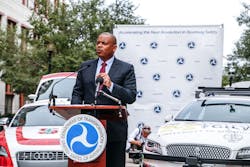News regarding autonomous vehicles has been ubiquitous over the past year. Whether it’s Tesla announcing the technology capability for fully autonomous vehicles, Ford’s intention to triple its autonomous fleet investment, or photos of the Apple self-driving cars in California—new developments continue to come through the newswires.
On Sept. 19, the U.S. Department of Transportation (DOT) issued a Federal Automated Vehicles Policy on the future development and implementation of autonomous cars. The guidelines issued by the DOT were put in place to help guide development and ensure vehicle safety. Anthony Foxx, secretary of the DOT, knows that transportation can make or break a city and can create many opportunities. Foxx shared how the DOT is monitoring new advancements in technology, specifically autonomous driving features, and looking toward the future.
Why was the time right for the DOT to issue a policy at the end of September? Issuing a Federal policy for automated vehicles in September was the first step to lay a path for the safe testing and deployment of new auto technologies that have enormous potential for improving safety and mobility for Americans on the road. We’re excited about the potential of automated vehicles to improve the way Americans get around, opening up new personal transportation options for millions. But more than anything, we are excited about the enormous safety potential of these new technologies.
What are the DOT's primary concerns regarding autonomous vehicles?
Our primary concern here at DOT is to make sure that lifesaving technologies are deployed safely and efficiently. This new policy sets the framework for the safe testing and deployment of automated vehicles. It also sets out a path to a unified national framework of state laws and regulations. Just as a human driver can take their car across state lines, we want to make sure that automated vehicles can be designed and deployed to a consistent set of standards. This will make sure the benefits are also shared nationwide.
Recently, there have been a few high-profile crashes involving vehicles with autonomous features. What is the DOT doing to ensure that autonomy is as safe as possible?
The Automated Vehicles Policy lays out a 15-point safety assessment for manufacturers, developers and testers of technologies. This safety assessment covers questions like, “Where and when is the vehicle designed to operate?” “How does the vehicle get to a safe state if one of the sensors fails?” and “How are you protecting the privacy of the vehicle occupants?” By working with the developers of this technology now, we’re building safety in at the front end in a new, proactive way.
It’s also important to remember that we do have significant enforcement authority to protect the traveling public. We have released an enforcement guidance bulletin making it clear that our authorities may investigate and recall any defect that creates an unreasonable risk to safety, which extends to automated technologies. If NHTSA determines that a vehicle is unsafe, we will use the DOT’s authority to recall it from the road.
Why did the DOT decide to let states create their own policies when it comes to autonomous vehicles?
State governments have an important role to play in the safe development and deployment of automated vehicles. Working with states, we wrote a Model State Policy that makes clear the Federal government will continue to be responsible for vehicle safety, while the states retain their oversight of matters including vehicle licensing and registration, traffic laws and enforcement, and motor vehicle insurance and liability. Our goal is to work with the states to support the establishment of a consistent national framework of laws and policy to govern automated vehicles.
What is the highest level of autonomy the DOT thinks any vehicle will reach in the next 10 years?
The short answer is we don’t know yet. The DOT strongly believes in the potential of these technologies. At the same time, we are committed to not prejudging the outcome. There is an enormous amount of innovation happening in this space, from big companies to inventors’ garages. We do not know what technology will be most successful, and we are not favoring one over another. Instead, we have built a policy that ensures the safe development and deployment of all of these technologies. The innovation experience and the market will decide what works best.
That said, technology is developing at a fast pace. Already several developers are testing Level 4 technologies, and some companies have made the commitment to deploy fully self-driving cars within the next five years. Our role will continue to be making sure these new technologies are safe, and that the lifesaving benefits of these new vehicles are harnessed to save more lives on U.S. roads.
What should collision repair shop owners be on the lookout for when it comes to autonomous cars?
While we may see a future where vehicles are involved in a lot fewer crashes, collision repair shops are going to have a role to play in making sure that automated cars on the road are safe. In automated vehicles, for example, all the sensors and systems that might be damaged in a crash will need to be fully repaired to allow automated systems to reactivate.
In fact, one of the 15 points in the Safety Assessment deals specifically with this issue. The Safety Assessment instructs vehicle developers to have a documented process for the assessment, testing and validation of how automated systems are reinstated into service after being involved in a crash. If sensors or other critical safety control systems have been damaged, the vehicle should not be allowed to operate in an automated vehicle until repaired.

